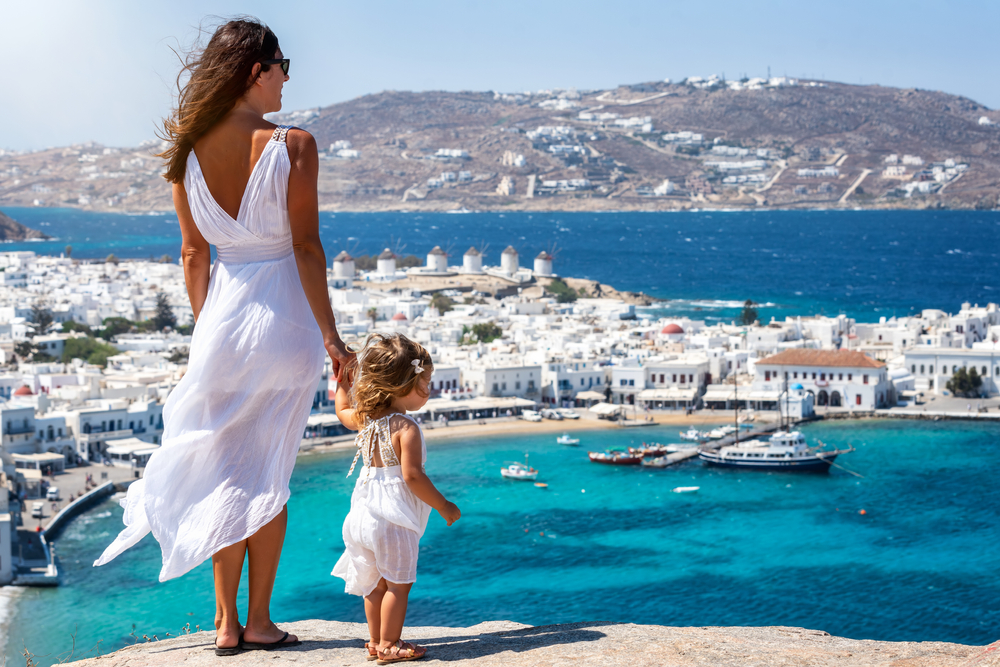Most people know Mykonos as an overtouristed destination with fancy yachts, celebrities, and nightclubs open until the early hours of the morning. However, Mykonos wasn’t always like this. Only about 5 decades ago, Mykonos was much like other Greek islands in the Cyclades, with their quiet fishing villages and slow pace of life.
In the past, as was captured by photographers like Lizy Manola and Robert McCabe, who visited Mykonos before the tourism boom, Mykonos was a quiet place. It used to be made up of rural families who lived in so-called “little villages.” A family’s land was called a “little village” because each family’s field contained a grouping of small buildings. Each building had its own function and supported the others.

Location, Location, Location
The most important feature was the courtyard, right in front of the main house. This is where most people in the family lived their day-to-day free time, either eating, cleaning, chatting, or sleeping. The interior areas are usually separated – the bedroom, kitchen, bakery, and barn. But they all lead into the courtyard.
Typically, the floor was made of a natural material- dirt, rock, or lime. The dimensions are usually tight – just enough to fit the basic necessities of life. Food and utensils are fit into holes in the walls, and a shelf is above the door for bread and dried rusks.

Working on a Farmstead
This is what the farmstead used to look like. Of course, these homes were just for rest times – usually, the rural men, women, and children were working in the fields to survive. Sunday was the only day for a break, and it usually involved going into town to go to church. The home was named after the family.
It was a difficult life with few comforts, where many hours were spent in the hot sun. There are not many of these homes left in Mykonos, and some are used by old residents who want to keep the traditional way of life. Some young families have modernized these homesteads or transformed them to holiday homes or bed & breakfasts.

Eating and Sleeping
The food in these homes is usually from the surrounding area and consists of vegetables from the garden, eggs from the family’s chickens, and dairy products. For sleeping, instead of the typical layout of a bed with a night table, traditional sleeping areas in Mykonos were usually on a raised wooden platform where you feel safe sleeping high up.

RIZES Folklore Farmstead
One place where the traditional Mykonos life can be experienced is the Rizes Homestay. The word “Rizes” in Greek translates to “roots.” In this farmstay experience, the Zouganeli family lets you tour a “little village” in Mykonos, where a family lived in the past supporting itself with its own produce and domestic animals. You can see all areas of the farmstead and hear about the function of each building.
As they describe on their website, “For us today Chorio is the wood oven that bakes the bread and the food of the day. The place we produce our cheese. The vineyard we take care of the grapes and make our wine. The garden with our vegetables, the trees with the juicy fruits. It is the home we grow in our family.”

Bread Making
The visitor can join in the bread making process, kneading the dough and baking it in a traditional oven. After this activity, you can eat a rich breakfast at the courtyard with the fresh bread and other local specialties. Then, you can get a tour around the property and learn more about the traditional Mykonos way of life.

Cooking Classes
In the cooking workshop, you get a tour around the farm and get to help prepare your own lunch. You can collect some of the ingredients for the recipe and meet the cook in the open-air kitchen when it is time to cook. You will learn about traditional local process there. As they describe on the website, “All together they prepare the dish, by following step by step the recipe. After the end of the process, the visitor enjoys the lunch/dinner that was prepared, at the traditionally decorated table, along with local wine and tsipouro.”









